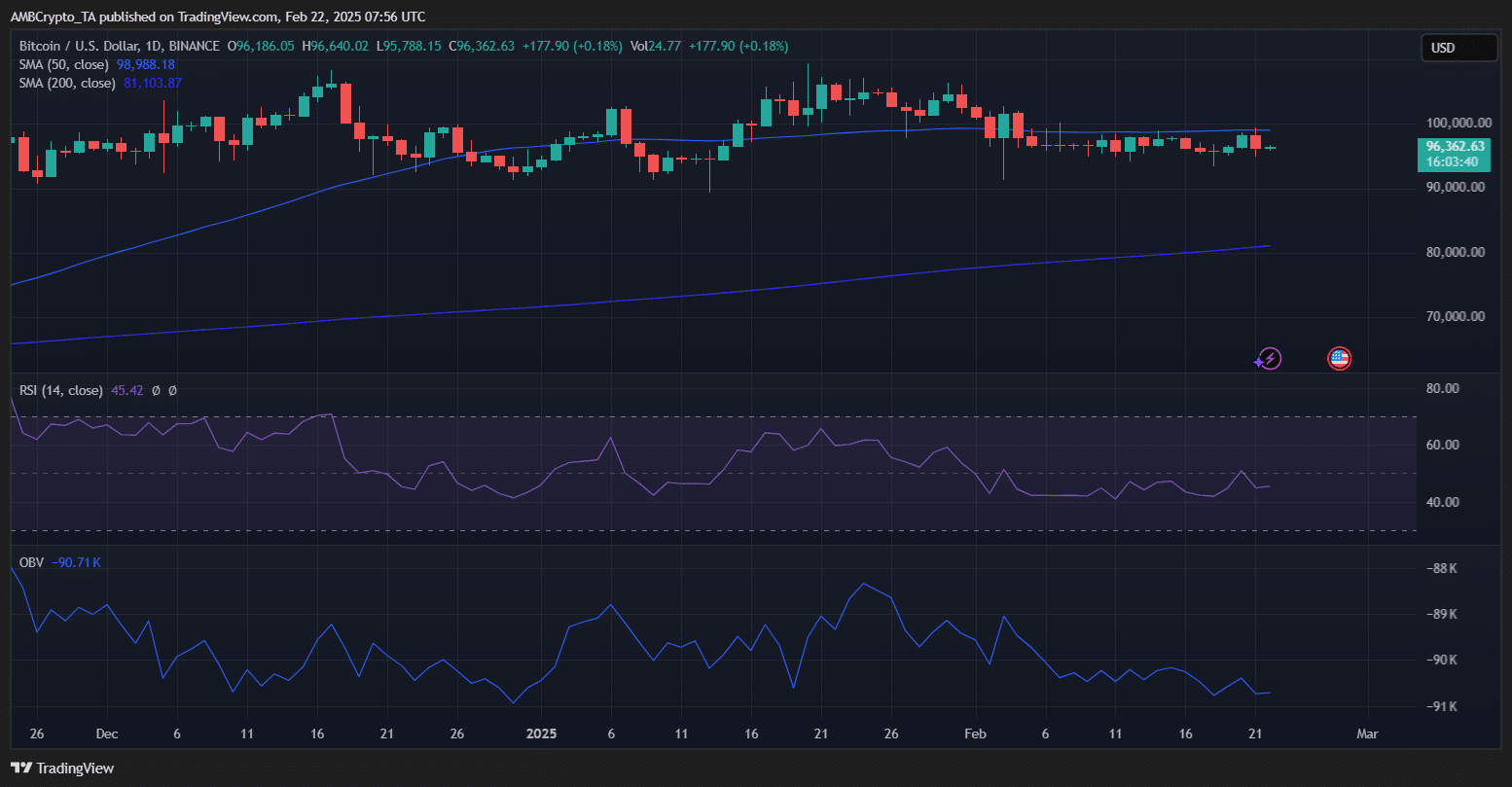| COINOTAG recommends • Exchange signup |
| 💹 Trade with pro tools |
| Fast execution, robust charts, clean risk controls. |
| 👉 Open account → |
| COINOTAG recommends • Exchange signup |
| 🚀 Smooth orders, clear control |
| Advanced order types and market depth in one view. |
| 👉 Create account → |
| COINOTAG recommends • Exchange signup |
| 📈 Clarity in volatile markets |
| Plan entries & exits, manage positions with discipline. |
| 👉 Sign up → |
| COINOTAG recommends • Exchange signup |
| ⚡ Speed, depth, reliability |
| Execute confidently when timing matters. |
| 👉 Open account → |
| COINOTAG recommends • Exchange signup |
| 🧭 A focused workflow for traders |
| Alerts, watchlists, and a repeatable process. |
| 👉 Get started → |
| COINOTAG recommends • Exchange signup |
| ✅ Data‑driven decisions |
| Focus on process—not noise. |
| 👉 Sign up → |
-
Bitcoin faces downward pressure as mining stocks struggle and operational costs rise, hinting at potential volatility in the cryptocurrency market.
-
With key indicators pointing to a decline in miner profitability, traders are urged to stay cautious as historic patterns suggest turbulent times ahead for Bitcoin.
-
“The correlation between mining stocks and Bitcoin’s price has been evident, with past crashes serving as warnings for current investors,” noted a source from COINOTAG.
As Bitcoin’s price is affected by declining mining stocks and rising costs, traders should remain vigilant about potential increased volatility ahead.
Impact of Mining Stock Trends on Bitcoin’s Future
Bitcoin mining stocks have traditionally been a barometer for the cryptocurrency’s price movements, often indicating shifts in market sentiment. Recent analyses have shown that when mining stocks decline, Bitcoin’s price tends to follow suit. Historical instances, such as those seen in early 2022 and late 2022, demonstrate a clear relationship where decreases in miner valuations emerged before notable downturns in Bitcoin prices.
Currently, the mining sector is witnessing a significant downturn, reminiscent of patterns observed before previous Bitcoin corrections. This correlation raises alarms among traders, as the total market cap of mining companies has again started to retreat, suggesting a turbulent road ahead for Bitcoin. If this trend persists, the possibility of miners liquidating their holdings to manage operational costs could significantly impact Bitcoin’s price stability.
Historical Patterns of Volatility Linked to Miner Profitability
Examining past trends, it becomes evident that Bitcoin often reacts to shifts within the mining sector. Reports have shown that heightened selling pressure from miners frequently precedes price corrections. Factors such as operational costs and miner profitability directly influence the broader market dynamics. For instance, after the last halving event, many miners began to operate at reduced profits due to the lower block rewards, prompting even the strongest players to reconsider their strategies.
| COINOTAG recommends • Professional traders group |
| 💎 Join a professional trading community |
| Work with senior traders, research‑backed setups, and risk‑first frameworks. |
| 👉 Join the group → |
| COINOTAG recommends • Professional traders group |
| 📊 Transparent performance, real process |
| Spot strategies with documented months of triple‑digit runs during strong trends; futures plans use defined R:R and sizing. |
| 👉 Get access → |
| COINOTAG recommends • Professional traders group |
| 🧭 Research → Plan → Execute |
| Daily levels, watchlists, and post‑trade reviews to build consistency. |
| 👉 Join now → |
| COINOTAG recommends • Professional traders group |
| 🛡️ Risk comes first |
| Sizing methods, invalidation rules, and R‑multiples baked into every plan. |
| 👉 Start today → |
| COINOTAG recommends • Professional traders group |
| 🧠 Learn the “why” behind each trade |
| Live breakdowns, playbooks, and framework‑first education. |
| 👉 Join the group → |
| COINOTAG recommends • Professional traders group |
| 🚀 Insider • APEX • INNER CIRCLE |
| Choose the depth you need—tools, coaching, and member rooms. |
| 👉 Explore tiers → |
The ramifications of these trends are compounded by the fact that if miners continue to struggle financially, Bitcoin may soon experience increased sell pressure, leading to a condition ripe for volatility.
Examining Rising Costs and Market Sentiment
The landscape for Bitcoin miners has changed dramatically in the post-halving environment. As operational costs rise, particularly in energy, miners are feeling the pinch. Current data indicates a marked decrease in the total market capitalization of mining firms, signaling that investors might be pricing in anticipated lower profitability. This financial strain raises questions about the long-term sustainability of many mining operations if conducive market conditions do not return soon.
| COINOTAG recommends • Exchange signup |
| 📈 Clear interface, precise orders |
| Sharp entries & exits with actionable alerts. |
| 👉 Create free account → |
| COINOTAG recommends • Exchange signup |
| 🧠 Smarter tools. Better decisions. |
| Depth analytics and risk features in one view. |
| 👉 Sign up → |
| COINOTAG recommends • Exchange signup |
| 🎯 Take control of entries & exits |
| Set alerts, define stops, execute consistently. |
| 👉 Open account → |
| COINOTAG recommends • Exchange signup |
| 🛠️ From idea to execution |
| Turn setups into plans with practical order types. |
| 👉 Join now → |
| COINOTAG recommends • Exchange signup |
| 📋 Trade your plan |
| Watchlists and routing that support focus. |
| 👉 Get started → |
| COINOTAG recommends • Exchange signup |
| 📊 Precision without the noise |
| Data‑first workflows for active traders. |
| 👉 Sign up → |
Moreover, competitive pressures within the industry further exacerbate the situation, as miners grapple with the need for improved operational efficiency. The prospect of forced liquidations looms large, as miners may be compelled to sell their BTC holdings to sustain their businesses. With Bitcoin’s price remaining stable yet vulnerable, such liquidations could lead to increased price fluctuations and a steeper drop, echoing sentiments expressed during previous critical periods.
Miner Sentiment and Broader Market Implications
February 2025 has proven to be a critical month for Bitcoin’s market sentiment, reflecting rising apprehensions about the health of mining stocks. Bitcoin has been hovering around $96,362, facing significant resistance levels, particularly with the 50-day moving average currently fixed at $98,988. This technical ceiling indicates weak momentum for BTC, with the recent RSI metrics signaling caution among traders.
| COINOTAG recommends • Traders club |
| ⚡ Futures with discipline |
| Defined R:R, pre‑set invalidation, execution checklists. |
| 👉 Join the club → |
| COINOTAG recommends • Traders club |
| 🎯 Spot strategies that compound |
| Momentum & accumulation frameworks managed with clear risk. |
| 👉 Get access → |
| COINOTAG recommends • Traders club |
| 🏛️ APEX tier for serious traders |
| Deep dives, analyst Q&A, and accountability sprints. |
| 👉 Explore APEX → |
| COINOTAG recommends • Traders club |
| 📈 Real‑time market structure |
| Key levels, liquidity zones, and actionable context. |
| 👉 Join now → |
| COINOTAG recommends • Traders club |
| 🔔 Smart alerts, not noise |
| Context‑rich notifications tied to plans and risk—never hype. |
| 👉 Get access → |
| COINOTAG recommends • Traders club |
| 🤝 Peer review & coaching |
| Hands‑on feedback that sharpens execution and risk control. |
| 👉 Join the club → |

Source: TradingView
As the Bitcoin market grapples with these dynamics, the implications for altcoins become evident, particularly those reliant on Bitcoin’s strength for their momentum. Traders and investors alike must closely monitor these signals to navigate what could be a tumultuous trading environment in the days ahead.
Conclusion
The interplay between declining mining stocks and rising operational costs could spell trouble for Bitcoin’s price sustainability. With historical patterns often repeating themselves, this section of the market warrants close attention. As Bitcoin stands on the brink of potential volatility, stakeholders must remain vigilant and responsive to market signals to mitigate risk.
| COINOTAG recommends • Exchange signup |
| 📈 Clear control for futures |
| Sizing, stops, and scenario planning tools. |
| 👉 Open futures account → |
| COINOTAG recommends • Exchange signup |
| 🧩 Structure your futures trades |
| Define entries & exits with advanced orders. |
| 👉 Sign up → |
| COINOTAG recommends • Exchange signup |
| 🛡️ Control volatility |
| Automate alerts and manage positions with discipline. |
| 👉 Get started → |
| COINOTAG recommends • Exchange signup |
| ⚙️ Execution you can rely on |
| Fast routing and meaningful depth insights. |
| 👉 Create account → |
| COINOTAG recommends • Exchange signup |
| 📒 Plan. Execute. Review. |
| Frameworks for consistent decision‑making. |
| 👉 Join now → |
| COINOTAG recommends • Exchange signup |
| 🧩 Choose clarity over complexity |
| Actionable, pro‑grade tools—no fluff. |
| 👉 Open account → |
| COINOTAG recommends • Members‑only research |
| 📌 Curated setups, clearly explained |
| Entry, invalidation, targets, and R:R defined before execution. |
| 👉 Get access → |
| COINOTAG recommends • Members‑only research |
| 🧠 Data‑led decision making |
| Technical + flow + context synthesized into actionable plans. |
| 👉 Join now → |
| COINOTAG recommends • Members‑only research |
| 🧱 Consistency over hype |
| Repeatable rules, realistic expectations, and a calmer mindset. |
| 👉 Get access → |
| COINOTAG recommends • Members‑only research |
| 🕒 Patience is an edge |
| Wait for confirmation and manage risk with checklists. |
| 👉 Join now → |
| COINOTAG recommends • Members‑only research |
| 💼 Professional mentorship |
| Guidance from seasoned traders and structured feedback loops. |
| 👉 Get access → |
| COINOTAG recommends • Members‑only research |
| 🧮 Track • Review • Improve |
| Documented PnL tracking and post‑mortems to accelerate learning. |
| 👉 Join now → |








